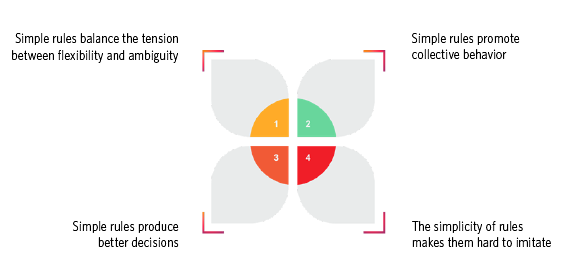Thought Leadership
Improve Agility in Your Organization Through “Simple Rules”

Why are some companies able to adapt and continuously evolve in a complex, dynamic environment while others struggle?
A primary challenge that organizations face over time is that they naturally drift towards efficiency and exploitation at the expense of flexibility and exploration. Firms add more policies, more manuals, more procedures and more rule books resulting in unidentified bottlenecks and organizational paralysis.
So structure is required and necessary for companies to operate, but too much structure can stifle agility and innovation. With increasing complexity and dynamism in the business environment, industry and workplace, this drift is becoming an increasingly challenging problem because additional structure can constrain action and make it difficult to adapt and adjust.
How can we as leaders counterbalance this drift towards efficiency and still maintain some flexibility? How can we balance the fundamental tension between flexibility and efficiency?
The answer is simple: simple rules.

Simple rules are shortcut strategies that we often call “rules of thumb.” They help us economize on time and effort by focusing our attention and simplifying how we think. They are strict but not restrictive. They provide some structure but not too much structure. They are powerful in driving innovation, change and promoting agility. Simple rules thus improve decision-making when time is short and when information is limited – common characteristics of many business environments.
Most importantly, simple rules promotes collective behavior. Because they are easy to remember, they can be shared and implement across a dispersed workforce. And we can remember them even when we are tired, stressed or anxious, times when we tend to disregard structure the most.
Simple rules fundamentally support strategy execution by producing better decisions that stimulates employee engagement and empowerment. When simple rules are created within the business and are aligned to the corporate strategy, organizations are able to adapt, evolve, innovate and grow faster.
Overall, the counter-intuitive insight is that when our personal and professional worlds become more dynamic and complex, the best strategies are the most simple.
Chris Bingham is a Phillip Hettleman Distinguished Professor of Strategy and Entrepreneurship and Area Chair of Strategy and Entrepreneurship at UNC Kenan-Flagler Business School.